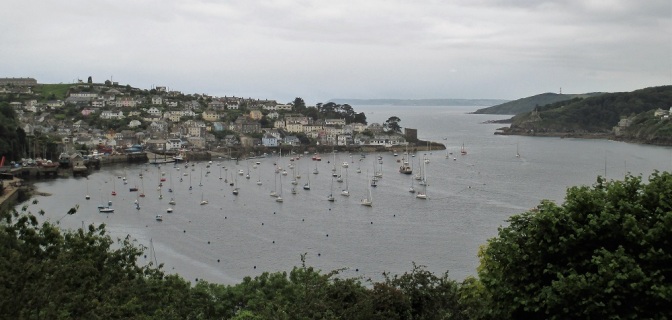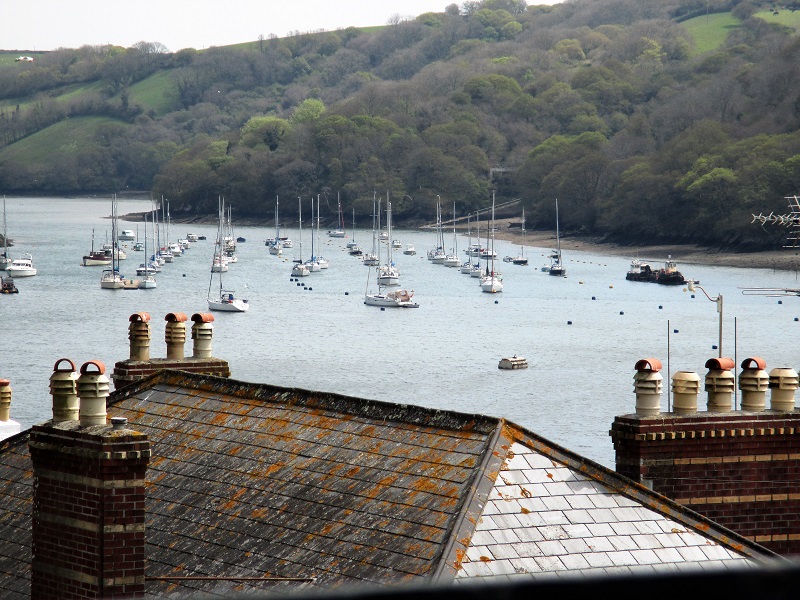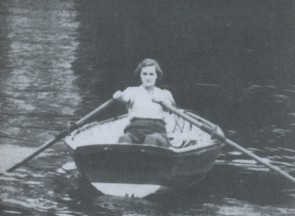Imagine a small coastal town perched on the edge of an estuary, houses peppering the hills, streets steep and narrow.

This is Polruan …
… known to some as Plyn.
Imagine a church, grey and stern in the manner of Cornish churches, sitting apart with an isolated farmhouse for a neighbour. This is Lanteglos church, the church of St Wyllow. It lies above the peaceful creek of Pont in the harbour of Fowey. Its location places it between the three settlements that it serves: Polruan, Bodinnick and Pont. There is a large and full churchyard around it; families lie here, gravestones tilting and worn, lichen spreading.
Imagine a wedding in October 1831. The wedding is between Christopher Slade and Jane Symons Salt. Christopher is aged 21 and has finally finished his apprenticeship as a shipwright which means he is free to marry his sweetheart, Jane, aged 18. Christopher and Jane’s families have lived in the area for generations. They are property owners and farmers and they have blessed the match. Guests will have walked across the fields to the church as the bells pealed to celebrate the union of the young couple. They will be married for 39 years, until Christopher’s death.
Imagine – a century later – a fictional wedding is conceived. It takes place in the past, in the era that Christopher and Jane would have known. It takes place at the same church. For this wedding the church is known as Lanoc.
She knelt by the window and looked across the harbour. In her heart were many strange unaccountable feelings, and she could name none of them. She loved Thomas dearly, but she knew in her soul there was something waiting for her greater than this love for Thomas. Something strong and primitive, lit with everlasting beauty.
One day it would come, but not yet.
Softly the bells pealed over the hill from Lanoc Church, then louder; ringing through the air.
“Janie – where are you to?”
She rose from the window and went away down where the wedding guests were waiting.
(The Loving Spirit p. 11)
Christopher and Janet will be married, in their fictional world, for 33 years. It will be Janet’s death which parts them, although always a piece of her heart had belonged to another.
 Imagine a dashing young major – having read the book which opens with that wedding – sailing his boat back and forth in Fowey harbour hoping to meet the young author who had captured his imagination. They meet in the spring; they marry in the summer. With a flash of bravado, her independent spirit flaring, it is the woman who proposes.
Imagine a dashing young major – having read the book which opens with that wedding – sailing his boat back and forth in Fowey harbour hoping to meet the young author who had captured his imagination. They meet in the spring; they marry in the summer. With a flash of bravado, her independent spirit flaring, it is the woman who proposes.

Imagine a wedding in July 1932. Very early in the morning, in order to catch the tide, a small party leave Bodinnick and arrive at Pont Bridge by boat and make the climb up the dark narrow path from the water, onto the steep lane which leads to the church of St Wyllow. The lane is bordered by high hedges replete with honeysuckle and dog roses. Daphne du Maurier marries Major Tommy ‘Boy’ Browning in the church she had called Lanoc when she wrote her first novel. Lanteglos, Lanoc – there were very few guests but the bells pealed that morning for her too. Their marriage also, will last 33 years and perhaps Daphne never gave her heart fully. Perhaps always a part of it pulsed amongst her stories.
Christopher and Jane, Thomas and Janet, Daphne and Tommy: three couples united through years and circumstance by an isolated Cornish church. And by ships. Imagine a boatyard, owned today by another local family but once owned by the young Christopher Slade who worked hard for his family and prospered. Among other vessels, the schooner, The Jane Slade was built here. His fictional counterpart owned it too. Here his family built The Janet Coombe. And in 1943 the yard was bought by Mrs D Browning. It was run for her until 1967.
Imagine a boatyard, owned today by another local family but once owned by the young Christopher Slade who worked hard for his family and prospered. Among other vessels, the schooner, The Jane Slade was built here. His fictional counterpart owned it too. Here his family built The Janet Coombe. And in 1943 the yard was bought by Mrs D Browning. It was run for her until 1967.
Imagine a view, sweeping and timeless. There will be different craft on the water; the view will change as the years pass, as the seasons turn. It will change as often as the weather changes mood. And yet it will not change.

On the morning of her wedding, Janet Coombe climbs to the top of Plyn and gazes at the view. Daphne opens her book thus:
Janet Coombe stood high on the hill above Plyn, looking down upon the harbour. Although the sun was already high in the heavens, the little town was still wrapped in an early morning mist. It clung to Plyn like a thin pale blanket, lending to the place a faint whisper of unreality as if the whole had been blessed by the touch of ghostly fingers. The tide was ebbing, the quiet waters escaped silently from the harbour and became one with the sea, unruffled and undisturbed. No straggling cloud, no hollow wind broke the calm beauty of the still white sky…
(The Loving Spirit p. 3)
And this is what I wrote, knowing nothing of The Loving Spirit, knowing nothing of Polruan, when first I saw that same view:
The quality of light on that January afternoon was pure magic: soft and shrouded, yet clear and calm. The gulls were quiet; boats sat motionless at anchor. Nothing moved – apart from the tiny passenger ferry ploughing a gentle furrow from the quay below to the opposite shore. It was timeless; it was beautiful. I felt I was being given access to something very private; I felt I was gazing into a living painting. This, I knew, was a scene oft-repeated; an everyday occurrence that was bathed in tranquil beauty and set entirely apart from the hustle and bustle of the rest of the world. It was a domestic scene: a watery passage from A to B with folks going about their business untouched at this time of year by tourists or traffic. And my heart sailed with that ferry. I wish I had thought to take a photo but in truth, a photo could not have done justice to the ineffable peace. The light on that afternoon was infused with peace.

I like to think that if we had stood here together, gazing down from the top of the little town: Jane Slade, Janet Coombe, Daphne du Maurier and I, our hearts would have been stirred alike. There are things which hold true beyond time and circumstance. There is a narrative in the landscape which is universal. It is a narrative which transcends fact and fiction, past and present, lives real and lives imagined. A narrative which speaks to the soul.

A companion piece for Du Maurier Reading Week, hosted by Ali.









Another beautiful post, Sandra. Thanks for sharing your thoughts and your photos.
LikeLiked by 1 person
It was a lovely post to write, Mary 🙂
LikeLike
Such a lovely companion piece to du Maurier’s. I agree with you that there are some archetypal views which resonate with all of us.
LikeLiked by 1 person
Thank you, Elizabeth. Yes, I agree absolutely about those archetypal views. I think immediately of several in the US 🙂
LikeLiked by 1 person
Wow! So reminds me of our walk. I am spellbound and lost for words. Imagine… xxx
LikeLiked by 1 person
Ahhh I had our walk in mind too, dear friend. Hope it won’t be too long before we can do something else like that 🙂 xx
LikeLike
What a lovely post, Sandra. I have goosebumps thinking about the four of you standing together, hearts alive with adventure and possibility.
LikeLiked by 1 person
Ghostly shadows, Liz 🙂 I shall have them all along with me when I’m next there 🙂
LikeLiked by 1 person
Du Maurier’s really got under your skin, hasn’t she? A lovely, resonant post.
LikeLiked by 1 person
Fraid so! I’ve always had a thing about her. One more post in mind (Fowey Festival focused) then I’ll let you move on from Daphne 😉
LikeLiked by 1 person
No, keep writing about her! Your enthusiasm is contagious.
LikeLike
Wonderfully constructed and beautifully written, Sandra
LikeLiked by 1 person
You’re very kind, Derrick, thank you 🙂
LikeLiked by 1 person
Oh, I love this–all you generations of women, walking the same route and seeing the same views. And, of course, you allowed me to re-walk it with you all. I went and read your two-part posts on doing the Hall Walk and enjoyed every word of those, too! I have very much the same photos from the same angles! And I really remember the pain in my knees and ankles, walking down the steep streets of Polruan at the end of the day!
LikeLiked by 1 person
Kerry, I thought of you while writing this, knowing that you had seen all these places yourself and also knowing your passion for women’s achievements. Jane Slade was one of those women that you would admire. But those Polruan streets are killers!
LikeLike
Beautiful photos and words, Sandra. I’ll revisit this post when I next read something by Daphne Du Maurier,
LikeLiked by 1 person
Thank you, Rose. I must move on from her books for a while but it’s very tempting to pick up just one more! 🙂
LikeLiked by 1 person
What a beautifully written post. And lovely photos. A magnificent view is certainly inspiring for artists as well as us mere mortals . I can’t claim any artistic potential myself, but I do love to take photos.
LikeLiked by 1 person
Thank you 🙂 And likewise re taking photos! How lucky we are in our age of digital photography. I lack the patience to construct ‘proper’ photos; I just point and shoot and hope. And it’s always a nice surprise to find I’ve got something worthwhile 🙂
LikeLike
Gosh and ye gods! Sandra- talk about goosebumps! How your writing resonates with me- how it uncorked one of those handsful of precious bottles of memory, put away to be opened as life dictates, but never to be forgotten. You have captured the essence of the place: your experience at Lanteglos church opened up that bottle for me: I sat, rather than stood there Your words convey exactly how I felt- one of those extraordinary days in life when an experience is ancient and almost spiritual. ” The loveliness, the silence and the peace” , to paraphrase DDM ( I suspect from Frenchman’s creek). She ( to me at least) was peerless in evoking all of this in her writing.
A wonderful few weeks of Du Maurier experiences, Sandra. I’m glad you are part of it and thanks for sharing it.xxx
LikeLiked by 1 person
I’m happy that it resonated with you, Pat. Knowing how you feel about DDM’s writing, that means a great deal 🙂 xx
LikeLike
I love what you wrote. Just gorgeous. ❤
LikeLiked by 1 person
Thank you, Amy 🙂
LikeLiked by 1 person
I wonder if the sense of timeless continuity of past, present and imagined in part flows from the irreducible connection to the sea (and its tides, wind and weather) upon which the isolated communities of such Cornish towns depended? Your writing conveys a remarkable sense of place, history, community and transcendence. It seems there is something about Cornwall that is spellbinding to those who are susceptible to its mysteries.
LikeLiked by 1 person
What perceptive thoughts, Carol; I shall enjoy pondering on this. On a personal note, the other place which stands out for me as having a supreme resonance and indeed a transcendence is the Kruger Park. There are probably many similar areas in SA which would have the same effect that I’ve not (yet) seen, but time in Kruger – away from the camps – was always numinous. Regardless of whether we saw any wildlife. Cornwall and Kruger do not have the sea in common but both are isolated and ancient spaces with a proud history.
LikeLiked by 1 person
I have also experienced that sense at several (wild) places in southern Africa and also in Greece. Its hard to describe, but almost tangible when one experiences it. Maybe it is merely as a result of being in an impressionable frame of mind, or maybe there is some kind of ancient energy present.
LikeLiked by 1 person
I think a combination of both your last suggestions. I’m currently with my father, who spent several years working in Mozambique and SA. He was just telling me that he has been hearing from his S. African friends that Kruger has changed a lot since we were there. (Last visit was 2012) Fast food outlets and many more visitors. The latter is good for the economy of course, but I would be sad to think some of that primeval isolation has been lost.
LikeLiked by 1 person
We have not been to Kruger for a very long time as it can be so busy with associated traffic and bustle, although I think that there are quieter regions and camps still to be found. We preferred to go camping in places in Botswana although that has changed a lot too with many more visitors and so we are less able to find the isolation and quietness we hope to find in such places. However, we are very fortunate in SA and there are many amazing places to be explored.
LikeLiked by 1 person